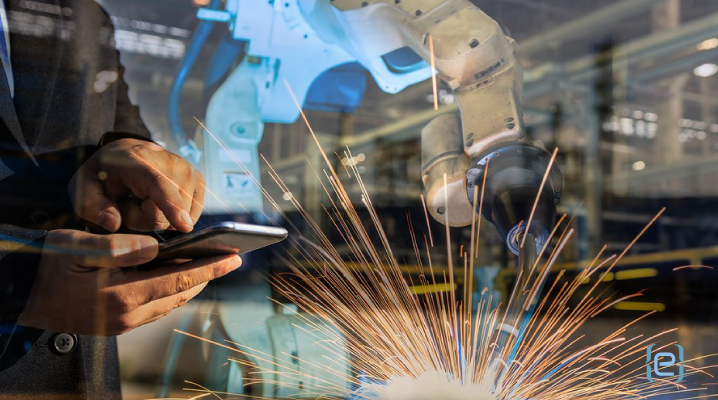Envision a smart factory where processes are fully automated using robots, 3D printing and artificial intelligence (AI). All equipment is interconnected and intelligent. Real-time data analytics drive continuous improvement and innovation. As in this scenario, the digital transformation in manufacturing, or industry 4.0, promises many benefits to business and consumers alike.
 As steam power and the assembly line did before, the digital transformation is set to revolutionize manufacturing. For example, Harley Davidson consolidated 42 buildings into a single, computer-controlled factory, reducing the production cycle from 21 days to six hours while lowering cost, inventory and injury rates.
As steam power and the assembly line did before, the digital transformation is set to revolutionize manufacturing. For example, Harley Davidson consolidated 42 buildings into a single, computer-controlled factory, reducing the production cycle from 21 days to six hours while lowering cost, inventory and injury rates.
Faster, Better, Safer, Lower Cost
Driven by data analytics and the Internet of Things (IoT), the digital transformation in manufacturing expands the limits of production. Some of the benefits include:
- Increased productivity—Augmented reality and 3D printing accelerate design processes and troubleshooting. Smart, connected machines send alerts before a failure occurs, reducing downtime while operating at peak efficiency.
- Mass customization—Modern consumers expect customized products at the price of mass production, and smart manufacturing delivers. Digitally-controlled production lines allow for customization at key steps in the fabrication process.
- Improved quality control—Sensors within the process identify issues and self-correct, improving quality and reducing the need for redundant inspections.
- Safer work environments—Sensors gather data about work environments, giving advanced alerts to potential hazards. Robots take the place of humans in dangerous situations.
- Reduced Cost—Data analytics more accurately predict product demand, allowing for streamlined inventory. Smart machines allow for greater flexibility in production. Thus, a single production line can produce multiple products with reduced staff.

Focus on Manufacturing Cyber-Security
With all the very real benefits of the digital transformation in manufacturing, some challenges remain. Manufacturing cyber-security tops the list of hurdles to clear. The more an organization utilizes the cloud and IoT-connected devices and machines, the greater the attack surface and risk of a breach.
Manufacturing is now second on the list of industries most targeted by cyber-criminals. Concerned business owners and managers will make cyber-security a priority from day one. As you embrace the IoT and the cloud, build a multi-layer cyber defense strategy to safeguard business assets.
Data Drives the Digital Transformation in Manufacturing
Smart manufacturing involves more than connected equipment and artificial intelligence. Automated processes and smart machines collect huge amounts of data at every stage of production. That big data must be stored, managed and analyzed.
Consequently, cloud computing and data analytics become critical components of a manufacturing digital transformation strategy. For businesses of all sizes, the cloud offers scalable solutions for storing and managing data.
Machine learning and analytics provide tools to massage the data and make it useful. For instance, with predictive analytics, engineers can anticipate machine issues and forecast product demand with greater accuracy.

Where to Begin?
It’s clear that business owners must embrace the digital transformation in manufacturing to compete in today’s market. However, moving from legacy equipment to a smart factory takes careful planning. Envision the future and carefully develop a strategy to reach that goal. Then, zero in to identify immediate projects that deliver a significant ROI in the near term.
Implementing cloud solutions is a good first step. Moving data and applications to the cloud will force your organization to automate paper-based processes. Once automated, information is easier to share, improving access to centralized data and increasing efficiency.
When building a smart production system, start by connecting a single asset or a single production line. Develop proof of concept in a small environment and then scale it up. The commitment to smart manufacturing is a commitment to a journey.
For example, GE is using a 3D-printing process known as additive manufacturing to make fuel nozzles for its new Leap Engine. Remarkably, what once required 20 separate parts is now produced in one print, resulting in nozzles that are five times stronger. The company plans to invest heavily in additive manufacturing to save money on a wider range of engine components.
Partner for Success
Joining forces with digital technology experts who keep their eye on the future facilitates an optimal road map for the digital journey. Those who make it their business to stay ahead of rapidly advancing digital technologies also design multi-layered proactive cyber-defense solutions for manufacturers.
An award-winning managed services provider, eMazzanti Technologies offers cutting-edge cloud, network, IoT and manufacturing cyber security solutions. Its certified technology experts help companies embrace the digital transformation and navigate their way to increased revenues, lower costs and greater profits.













